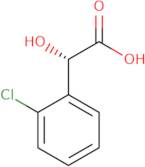(S)-2-Chloromandelic acid
CAS: 52950-19-3
Ref. 3D-FC20244
| 1g | Ausgelaufen | ||
| 2g | Ausgelaufen | ||
| 5g | Ausgelaufen | ||
| 10g | Ausgelaufen | ||
| 500mg | Ausgelaufen |
Produktinformation
- (a-S)-2-Chloro-a-hydroxy-benzeneacetic acid(S)-2-(2-Chlorophenyl)-2-hydroxyethanoic acid(S)-(+)-2-Hydroxy-2-(2-chlorophenyl)acetic acid
- (+)-2-Chloromandelic acid
- (2S)-2-(2-Chlorophenyl)-2-hydroxyacetic acid
- (S)-(+)-2-Hydroxy-2-(2-chlorophenyl)acetic acid
- (S)-2-(2-Chlorophenyl)-2-hydroxyethanoic acid
- (S)-2-Chloromandelic Acid
- (αS)-2-Chloro-α-hydroxybenzeneacetic acid
- Benzeneacetic acid, 2-chloro-α-hydroxy-, (S)-
- Benzeneacetic acid, 2-chloro-α-hydroxy-, (αS)-
- L-(+)-2-Chloromandelic acid
- Mehr Synonyme anzeigen
(S)-2-Chloromandelic acid is an organic compound that is used as a building block in organic synthesis. It is also a substrate for lipases, which hydrolyze the ester to produce mandelic acid and choline. (S)-2-Chloromandelic acid has been shown to be an excellent immobilizing agent in the synthesis of racemic compounds. The reaction rate of this immobilization process can be influenced by the use of different solvents and simulations have shown that it is kinetically controlled. The kinetic constants for this process are dependent on the type of substrate binding site present on the enzyme. This substrate binds to at least two sites on the enzyme, with one site being more reactive than the other. This causes a metastable equilibrium that enables products to form from both substrates, which leads to stereoselectivity in product formation.





